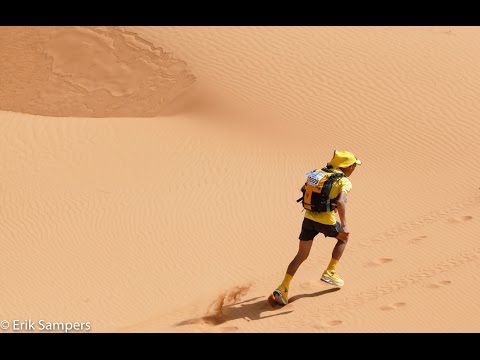Venturing into the unknown and facing the wilderness of the unforgiving Sahara, the Marathon des Sables (MDS) lays down the gauntlet as the Toughest Footrace on Earth. An event where resilience is not just admired but demanded, the MDS is more than a race; it’s a test of the human spirit. Since its inception, over 25,000 individuals have accepted this daunting quest, caught in the grip of adventure and self-discovery. As we delve deep into the grandeur and severity of the Sahara, it’s essential to understand what galvanizes these intrepid souls to confront the ultimate Sahara challenge.

Confronting the Sahara: Inside the Marathon des Sables Experience
The Marathon des Sables isn’t your regular 26.2-mile jaunt; it’s an ultra-marathon of epic proportions. Imagine championing over 250 kilometers across unforgiving desert terrain, facing sweltering temperatures that often soar above 50 degrees Celsius. It’s no wonder that with a drop-out rate close to 50%, this race is etched into the chronicles of endurance events.

Origins and Evolution of the Marathon des Sables

| Category | Information |
|---|---|
| Event Name | Marathon des Sables (MDS) |
| Edition | 37th |
| Date | 21 April to 1 May 2023 |
| Location | Southern Morocco |
| Organiser | ATLANTIDE ORGANISATION INTERNATIONALE |
| Under the Aegis of | MOROCCAN MINISTRY OF TOURISM |
| Participation | |
| Race Type | Multi-stage ultra marathon (footrace) |
| Environment | Sahara Desert |
| Distance | Approximately 250 km / 155 miles (varies yearly) |
| Duration | 7 days |
| Difficulty Level | Extremely High |
| Average Temperatures | Daytime: up to 120°F (50°C) or higher |
| Survival Aspect | Each participant must be self-sufficient; carrying his/her own backpack with food and equipment |
| Equipment Required | Backpack, food, sleeping gear, survival equipment, etc. |
| Drop-Out Rate | About 47% |
| Notoriety | Labeled as the “Toughest Footrace on Earth” |
| Participant Requirements | |
| Potential Hazards | Extreme heat, rough terrain, sand storms, risk of dehydration and heatstroke |
| Benefit to Participants | Sense of achievement, pushing physical and mental limits, unique experience |
Preparing for the Marathon des Sables: More Than Just Training

The Route Unveiled: Navigating the Sands During the Marathon des Sables

Endurance on Display: Personal Stories From the Dunes
Marathon des Sables by the Numbers: A Statistical Approach
Beyond the Race: The Marathon des Sables’ Broader Impact
Technology in the Sahara: High-Tech Advancements at the Marathon des Sables
Embracing the Ultimate Sahara Challenge: The Finish Line Isn’t the End
In an innovative wrap-up, we circle back to the essence of what the Marathon des Sables engrains in those it ensnares: a profound respect for the might of the Sahara and an intrinsic curiosity for the depths of one’s own fortitude and soul. The footprints etched into Saharan sands might blow away with the winds of time, but the legacy of those who dared to conquer the Marathon des Sables will dance eternally with the dunes, a perpetual testament to the stamina of the human spirit.
The Ultimate Sahara Challenge: Marathon des Sables
The Marathon des Sables, fondly known as MdS, is no mere jaunt through the park. Speaking of endurance, if you’ve ever binged through the How many Rocky Movies are there, you’ve seen Rocky Balboa’s stamina in the ring. But even that pales in comparison to MdS racers, who tackle a whopping 250 km across the unforgiving Sahara. Over six days, contenders face a blistering sun that could cook an egg on the spot, if they could afford the weight of an egg, that is.
As participants gear up for this grueling race, they adopt a similar intensity to an actor preparing for a role. Just like preparing for a blockbuster hit, such as Prisoners 2, runners dive deep into physical and mental prep to survive this furnace of a challenge. They may not have a star-studded Prisoners cast behind them, but every racer becomes the hero of their own grueling story. And remember, once you cross the finish line, it doesn’t end there. The Pt. 2 is surviving the recovery!
Preparation for the Long Haul
The prep for the Marathon des Sables could rival any bridal shower dress planning. Runners must pack with precision, considering every ounce as they are required to be self-sufficient – carrying their food, sleeping gear, and medical supplies. And while perhaps a runner might dream of a lavish meal at universal Citywalk Restaurants after the race, during the event, dining is a stripped-down affair of energy bars and the occasional treat akin to a culinary Ramen 101 to keep spirits high.
But it’s not all gut-busting work – there’s a strange beauty to the ordeal. Much like witnessing Doja Cat’s dramatic entrance at the Doja cat Met gala 23, completing the Marathon des Sables offers a surreal sense of achievement. And for some, this race is a memorial of a different sort. In instances like a jersey shore football player Dies, these racers often find solace and a sense of connection by tackling monumental feats like the MdS. In the end, it’s about pushing beyond the mere physical journey, delving into the vast sands of personal discovery and transformation.

How many people drop out of MARATHON DES SABLES?
Nearly half the entrants, a staggering 47%, wind up dropping out of the MARATHON DES SABLES due to the intense heat and grueling conditions.
How long does it take to prepare for MARATHON DES SABLES?
Getting ready for such an extreme event usually takes upwards of six months to a year of dedicated training, with a focus on building endurance, strength, and the mental grit required for the harsh desert environment.
What is the hardest footrace on Earth?
The MARATHON DES SABLES is often called the hardest footrace on Earth because it’s a brutal multi-day trek across the Sahara Desert, pushing participants to their limits with scorching temperatures and daunting terrain.
How do I participate in MARATHON DES SABLES?
To get in on the MARATHON DES SABLES action, you need to sign up through the official website, get a medical certificate proving you’re fit as a fiddle, and then get cracking on some serious training and gathering all the essential gear you’ll need to carry on your back.
Do people walk the MARATHON DES SABLES?
Sure, some do walk it! Not everyone at the MARATHON DES SABLES is sprinting. Given the heat and the distance, many take a steady pace, alternating between walking and running, whatever it takes to cross that finish line.
Can anyone do MARATHON DES SABLES?
Absolutely, anyone determined and in good physical shape can take on the MARATHON DES SABLES. Mind you, it’s not a walk in the park, and you’d better be prepared for the physically taxing challenge ahead.
How many stages are there in MARATHON DES SABLES?
This sweat-inducing saga, the MARATHON DES SABLES, has a total of six stages, including one long haul that can be a real bear, often stretching more than 50 miles.
How do you train for Des Sables?
Training for Des Sables isn’t just your regular jog around the block. It means ramping up your miles, conditioning your body for the heat (think sauna sessions), and getting comfortable with the backpack you’ll be living out of during the race.
How do you pronounce MARATHON DES SABLES?
“Marathon deh Sah-bluh” rolls off the tongue with a French lilt—that’s how you say MARATHON DES SABLES if you’re aiming to impress.
What is the longest distance David Goggins has ran?
David Goggins, the endurance athlete and tough cookie, has run 205 miles non-stop during a 48-hour race, flexing what seems like superhuman stamina.
What’s harder than an Ironman?
When it comes to endurance challenges, a Double Ironman, which is double the distance of a traditional Ironman triathlon, is often considered tougher—just imagine double the swimming, biking, and running, and you’ll get the picture.
What is the longest race humans run on foot?
Ultramarathons win the title for the longest footraces—these beasts can span hundreds of miles. The Self-Transcendence 3100 Mile Race, which requires runners to complete the distance in 52 days, is a prime example of what human legs and willpower can endure.
How much does it cost to go to the Sahara race?
Ponying up for the MARATHON DES SABLES isn’t cheap—the cost to join this desert dance can set you back around €3,000 to €4,000, which covers the race entry, accommodations, and meals, but you’ll need to handle your travel to Morocco and gear separately.
How do I register for the MARATHON DES SABLES 2024?
Mark your calendar and keep an eye on the race’s official website for information on registration for the 2024 MARATHON DES SABLES, and when the race opens up for entries, be ready to jump on it as spots can fill up fast.
Where does the Sahara race start and finish?
The Sahara race, part of the 4 Deserts Race Series, traditionally kicks off in the imposing dunes of the Sahara Desert and wraps up in a grand fashion at an established finish line, all after pushing competitors through a gauntlet of scorching sands and rocky plateaus.
How many people give up on a marathon?
Marathon finish lines often see a wave of dropouts hit around the 18 to 20-mile mark—that’s where many folks hit ‘the wall’ and some decide they just can’t push through.
Where do most people quit a marathon?
Digging into the numbers, the general consensus is most people throw in the towel around the 20-mile marker. That’s where things get real tough, and the temptation to call it quits gets mighty strong.
How many people get into the marathon?
The world of marathons is a mixed bag, with some races limiting entries to a few thousand while others, like the iconic New York City Marathon, can have over 50,000 runners lacing up.
How many people are running the Disney marathon?
The Disney marathon is a magical affair drawing over 25,000 participants who come for the dash through the theme parks and the chance to high-five their favorite Disney characters along the route.










